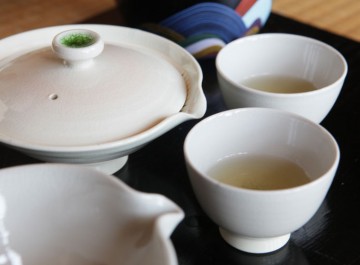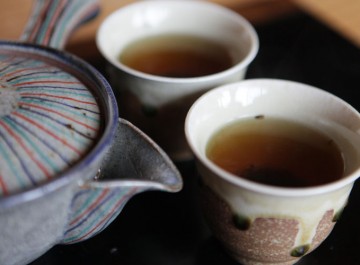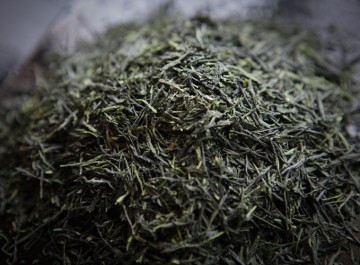Many expensive teas you find in the market could end up just being marked up for the “brand” of the store it is sold at. We often have customers that ask if we have a specific brand of tea, which is their “favorite brand”, and will refuse to buy anything cheaper, even though our “cheaper” tea that we offered actually would be considered a higher grade tea if we looked at the wholesale price. What many do not know, even in Japan, is that the brand of the tea often does not matter as it is all in the blend, and the blend is mostly dictated before the tea is even branded. So, in reality, the brand and the price, may not actually equal the blend or quality.
At Matabay, unlike many, many tea retailers, we have full control over what we offer due to the fact that we as an extended family make what we provide. The price does reflect the actual value of the tealeaf and blend. Yet, once again, just because it is a more expensive tea, does not mean it is the right tea for you.
So, what is the right Tea for you?
Let us walk you through the various Japanese teas that we have to offer.
Matcha
Matcha : Matcha is Tencha (Gyokuro leaves, dried, yet not “rolled”) ground to a fine powder using a stone mill. The powder is so fine, that it dissolves into the hot water. Since you are drinking the “whole leaf”, the nutrition value is higher than other teas, but also has the highest amount of caffeine per gram. One thing to note though is that Matcha is divided into 3 categories. Koicha, Usucha, and “commercial/cooking” matcha. Koicha being the highest grade, Usucha the next, and “commercial/cooking matcha” is the lowest grade.
Koicha: Koicha, is the higher grade Matcha that is used in formal tea ceremonies. Its characteristics are in the name itself. Koi, means deep or thick, and Cha means tea. Koicha is Matcha prepared using larger scoops of Matcha, creating a thick blend of tea (sometimes so thick it is more of a paste than a drink!). In other words, it requires the good Matcha that will remain sweet and rich, without a making the tea bitter, no matter how many scoops you use.
Usucha: Usucha, is the common grade Matcha that is used for casual tea ceremonies or for a casual cup of Matcha. Usucha, otherwise known as Ousu, means “thin” or “light” tea. The trick is to use just as much tea to enjoy the full potential of the Matcha, without using too much, which could cause the tea to taste bitter. Usucha, can also be used for cooking, baking, and other tea drinks. The color will be brighter, and the taste fuller, compared to “cooking Matcha”.
Gyokuro

Gyokuro : Gyokuro tea, which originated right here in Uji, is both made, and prepared differently than Sencha or other green teas. As the first shoots of tea start to appear in April, the entire gyokuro field/plantation is covered to block the sun. By shutting out the direct sunlight, the tea farmers are able to to reduce the rate of photosynthesis, resulting in high levels of theanine, the amino acid responsible for the full-bodied, less bitter tea that has a hint of sweetness. Gyokuro tea in Uji, is prepared a little differently than many places in Japan. First, you tend to use a lot of tea leaves compared to the amount of water used, resulting in one serving being 20ml. Although you only get a few sips, once you try drinking Gyokuro this way, you will see why. The first infusion, prepared with water between 50 to 60C is packed with full flavor (umami), and sweetness. The second infusion, prepared with hotter water, is where you enjoy the earthy bitterness of the tea.
Kabusecha
Kabusecha: Kabusecha, is half way in-between Gyokuro and Sencha. Where in Gyokuro, the tea plantation is covered for a minimum of 20 days, Kabusecha is usually only covered for 2 weeks or so, and the tea trees are covered directly, rather than having the whole plantation covered. The result is similar than Gyokuro, but is a lighter to the taste, and is to be prepared like regular Sencha. The taste is much more mellow than regular sencha, and has a hint of sweetness that remains as a pleasant aftertaste.
Sencha
Sencha : Sencha is the tea that transformed Japanese tea into what it is today, and is the tea that most people picture when they think of Japanese tea. Due to the fact that it is not covered, and grows under the sunlight, it is full of vitamin C and has a relatively high level of tannin (the source of its sharpness and bitterness). It is straight forward, sharp, both bitter and sweet, and has a refreshing fresh grassy flavor. Using 3g per serving, one cup is normally between 60 to 80cc, water temperature is 90C, and takes 60 seconds to prepare.
Fukamushi Sencha
Fukamushi Sencha : Fukamushi Sencha, is a Sencha that is steamed even more than regular Sencha. The literal translation of “Fukamushi” is “Deeply Steamed”. By adding more steam time, the tealeaves get split, and the color of the tea becomes a deeper shade of green. The taste is stronger, yet mellower then regular Sencha. The value of vitamin C is slightly lower than regular Sencha, but is higher than Gyokuro. Since more of the tea is dissolved into the water, the actual color of the tea will not be as clear, and will be slightly clouded.
Karigane (Kukicha)
Karigane (Kukicha): Karigane uses the stems of the tealeaves used for Gyokuro or Sencha. Karigane made from Gyokuro leaves, while considerably cheaper than Gyokuro itself, is quite a treat. The price is cheaper than Gyokuro because it is a by-product of Gyokuro, but the flavor is worth far more than its price. Good Karigane could beat most common teas hands down. The flavor is sweet and mellow, full of umami, with a mild undertone of grassiness. Karigane made of Sencha, also known as Kukicha, is a by-product of Sencha, and has a yellow-green color when brewed. Both are excellent choices.
Houjicha
 Houjicha : Houjicha, is roasted Japanese tea. Houjicha (also spelled Hojicha), is refreshing, toasty, nutty, earthy and somewhat caramelly and at times smoky, and is one of the most favored teas for after a meal. The caffeine quantity is the lowest out of all Japanese teas, and is considered suitable for even small children, or for drinking a late night cup of tea. The color of the brewed tea is brownish, and it is the easiest of all the teas to make. Hojicha also reminds some people of a light coffee, and for those who are into experimenting with food and teas, can be used to make an excellent tea-cake, and an amazing Hojicha latte.
Houjicha : Houjicha, is roasted Japanese tea. Houjicha (also spelled Hojicha), is refreshing, toasty, nutty, earthy and somewhat caramelly and at times smoky, and is one of the most favored teas for after a meal. The caffeine quantity is the lowest out of all Japanese teas, and is considered suitable for even small children, or for drinking a late night cup of tea. The color of the brewed tea is brownish, and it is the easiest of all the teas to make. Hojicha also reminds some people of a light coffee, and for those who are into experimenting with food and teas, can be used to make an excellent tea-cake, and an amazing Hojicha latte.
Genmaicha
Genmaicha: Genmaicha, sometimes known as “popcorn tea” is a blend between green tea and roasted and popped rice. It is a perfect breakfast tea, and is often favored for later in the evening because of its mellow, yet toasty flavor. Originally, Genmaicha was drank by fasting priests that had to go long ways between meals and/or by poor farmers that used the popped rice as “fillers” to keep the tea economical. However, due to the fact that it simply tastes great, it is hard to find a Japanese household that does not have at least one bag of Genmaicha in their cupboard.
Sobokucha
Sobokucha: Sobokucha is what we call the “farmers blend”, and is often what the tea farmers’ drink. It is basically your un-refined Sencha, which includes both the stem and the leaf, and is quite casual. In fact, it is so casual that most tea vendors will not even carry it, no mater how high the quality. After all, why sell un-refined tea, when you can refine it and sell it for a higher price, right? However, its straightforward simplicity, low price, and earthy flavor are what keep its fans coming back for more. Sobokucha is down to earth, full of flavor, high in tannin, and has plenty of vitamin C.
Konacha
Konacha: Konacha is a by-product of Matcha, Gyokuro, and Sencha. Although not a fine powder like Matcha, Konacha is made of the tea dust and tea flakes that fall off the leaf while processing the teas. Due to the fact that Konacha is composed of tea dust and small flakes, the tea is quickly absorbed into the hot water, and is what is used in most Sushi restaurants. The tea is quick and easy to make, rich in flavor, and is also ideal for using in cooking. Also, due to the fact that it is a by-product of making other teas, the price is considerably lower, while the taste and quality is just the same. Often it is easier to find good Konacha than it is to find good Sencha, especially if you are looking in the same price range. The one drawback of Konacha, is that most of the flavor is “used up” in the first infusion, and is not meant to brew a second infusion, unless that is, you like drinking a cup of slightly green warm water.
Tea Bags
Tea Bags: The tea bags that we offer at Matabay, are not your regular “green tea, tea bags” that you will find at the local supermarket or in some online shops. Not only do we use the finest Uji tealeaves, these teabags are designed to make a brew that could compete with the best of teas. Both the Gyokuro and the Sencha not only compete with most green teas that are offered in the market today, but they can beat them hands down. If you do not have the time, or equipment for “formal” green tea, or just want a great brew at the office or anywhere you go, this may be the option for you.
Whichever tea you choose, we guarantee that it will be of the highest quality, and that it will be total satisfaction.
If you are new to tea, what we recommend is for you to try our mid-ranged teas first. Don’t worry; any tea you buy here will be far superior to anything you can get off the shelf in the local market.
If you are trying Matcha for the first time, or are not sure about our quality, you cannot go wrong with the Matabay Matcha. Especially if you are going for Koicha. The mid-range Usucha is also quite nice.













